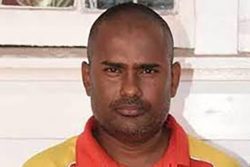Sentenced to life in prison for the 2014 chopping death of a man whom he claimed provoked him and over which he said he retaliated in self defence, Dhupaul Singh has appeal-ed his sentence which he says is severe.
Following his conviction back in 2016, Singh in his notice of appeal contended, too, that the trial judge had erred in law in the directions given on provocation.
Singh’s appeal comes up for hearing at 10 this morning before the Guyana Court of Appeal.
Singh, called ‘Tailor man’ or ‘Tailor’ had been unanimously convicted by a jury of the September 2nd, 2014 murder of Mahaica farmer Balkissoon, at Helena Number Two, Mahaica.
The incident was said to have stemmed from an argument the two men had following insults hurled by Singh regarding Balkisson’s wife.
Justice Jo-Ann Barlow had imposed the life sentence on Singh, ordering that he was only to be considered eligible for parole after serving a minimum of 25 years.
Through his attorney Mark Conway, the appellant is arguing among other things that established legal principles in relation to the law on provocation were “wholly absent” in the judge’s summation of the case to the jury.
The defence is arguing that what was said by the judge on the issue of provocation has materially failed to capture an exposition of the law required for provocation.
They submit further that the judge erred by not marshalling the facts or evidence that may have yielded a finding of manslaughter by reason of provocation and that the jury was not alerted by the judge of the facts or evidence that they may consider in deciding if provocation was an issue.
Conway pointed out that the trial court had heard that his client had said, “as I was walking going, I see Balkissoon coming with a bicycle riding. When he reached opposite where I was he stopped. So I asked him why you calling my name insulting me at my home. He take out his cutlass and put down his bicycle. He came towards me and pelt a chop at me I jump off and I was far away and the cutlass did not ketch me. He prepare and rush to me for the second time. I raised the cutlass and I am pelt a chop for self defence of myself.’
Against this background, and given the testimonies of witnesses, Singh contends through his lawyer that the judge’s summation failed to reflect an adequate summary and analysis of the facts of his case.
Conway contends that this should have been presented to the jury for its deliberation as to whether the appellant was provoked by the deceased; even as he advanced that this failure is a material omission which may have deprived the appellant of a verdict of guilty of manslaughter by reason of provocation.
Regarding the issue of the severity of the sentence, the lawyer argues on behalf of his client that the sentence imposed does not reflect guidelines or principles laid down in case law, noting that the judge should have stated that full credit be given for any time spent on remand.
As a result, counsel argues that a sentence was rendered which was “unjustified” and “manifestly excessive.”










